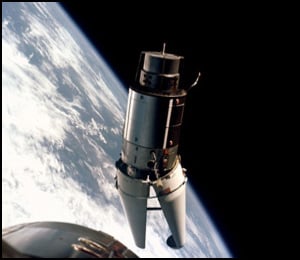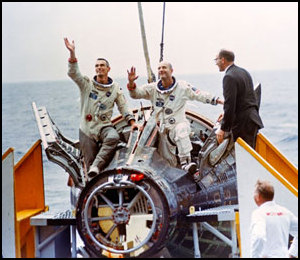Spotlight
An Apollo 50th Anniversary Moment
Written by: developer
 Suit & Tether
Suit & Tether
by John Holst, Space Foundation Research Analyst
After aborting the Gemini IX mission in May 1966 because of a target vehicle launch failure, NASA moved with uncharacteristic swiftness to implement a slightly modified mission plan nearly two weeks later. The new mission, Gemini IX-A, would be piloted by the same astronauts billeted for Gemini IX, Tom Stafford and Gene Cernan. The pilots' primary mission objective would be to rendezvous and dock the Gemini IX-A capsule with the new target vehicle, the Augmented Target Docking Adaptor (ATDA). One of the astronauts would also "float" outside the capsule, conducting an extravehicular activity (EVA), including donning and getting around in space using a new tool--the Astronaut Maneuvering Unit (AMU).
 Stafford and Cernan began their three-day journey aboard Gemini IX-A on June 3, 1966. Once in orbit, the astronauts found and locked onto the ATDA using radar. They piloted their spacecraft closer, eventually drawing near enough to see the ATDA and the unexpected surprise it held for them. The shroud ensconcing the ATDA during launch had failed to come off. Instead, the shroud was partially open, looking to Stafford like an "angry alligator" with its mouth open menacingly. Lanyards held the shroud together. They had been taped to the shroud before launch, and unexpectedly adhered to the shroud in orbit. There was no way for Gemini IX-A to dock with the ATDA while the shroud was still on, and after many ideas were discussed, it was decided there was no safe way to remove the lanyards.
Stafford and Cernan began their three-day journey aboard Gemini IX-A on June 3, 1966. Once in orbit, the astronauts found and locked onto the ATDA using radar. They piloted their spacecraft closer, eventually drawing near enough to see the ATDA and the unexpected surprise it held for them. The shroud ensconcing the ATDA during launch had failed to come off. Instead, the shroud was partially open, looking to Stafford like an "angry alligator" with its mouth open menacingly. Lanyards held the shroud together. They had been taped to the shroud before launch, and unexpectedly adhered to the shroud in orbit. There was no way for Gemini IX-A to dock with the ATDA while the shroud was still on, and after many ideas were discussed, it was decided there was no safe way to remove the lanyards.
In spite of the setback, the astronauts could still conduct rendezvous maneuvers with the ATDA, and did so. The rendezvous exercise was intended to simulate the rescue of a lunar module in low orbit around the Moon using an Apollo command module. The crew rendezvoused successfully with the ATDA three times during the Gemini IX-A mission. The crew rested and began preparations to complete the next mission objective: the EVA. The EVA would help NASA and its explorers understand more of how humans would be able to work in a pressure/space suit, and apply that understanding to the Apollo program.
Gemini IX-A was the second time a U.S. astronaut conducted an EVA (Ed White was the first to do so in 1965). For this mission, Cernan was the one selected to step outside the Gemini capsule. He had trained for the EVA during the months leading to the mission. Cernan wore a special EVA suit, one with a bit more insulation protecting him from the space environment as he worked outside the capsule. His suit was connected to the Gemini capsule with an umbilical. The umbilical supplied oxygen, communications, and power to Cernan as he climbed and worked outside the capsule hurtling above the Earth.
 Cernan's EVA lasted two hours and eight minutes. That time outside the capsule in the suit was not trouble-free, as the suit that was supposed to protect Cernan was giving him very difficult time. Just the very low pressure in the suit against the vacuum of space had stiffened it to an almost unbearable point for Cernan. Eventually his face shield fogged up. More can be read about his bout with the suit here. The EVA was such a stressful experience to Cernan that Stafford, as commander of the crew, called off any attempt to don and test the AMU, which wasn't critical for the Apollo program.
Cernan's EVA lasted two hours and eight minutes. That time outside the capsule in the suit was not trouble-free, as the suit that was supposed to protect Cernan was giving him very difficult time. Just the very low pressure in the suit against the vacuum of space had stiffened it to an almost unbearable point for Cernan. Eventually his face shield fogged up. More can be read about his bout with the suit here. The EVA was such a stressful experience to Cernan that Stafford, as commander of the crew, called off any attempt to don and test the AMU, which wasn't critical for the Apollo program.
The capsule and crew came back safely to Earth on June 6. The crew's exercises for rendezvous and EVA helped confirm contingency responses in outer space, while providing extremely valuable information of spacesuit design and function for astronauts who would be out and about on the Moon's surface.
This article is part of Space Watch: June 2016 (Volume: 15, Issue: 6).


